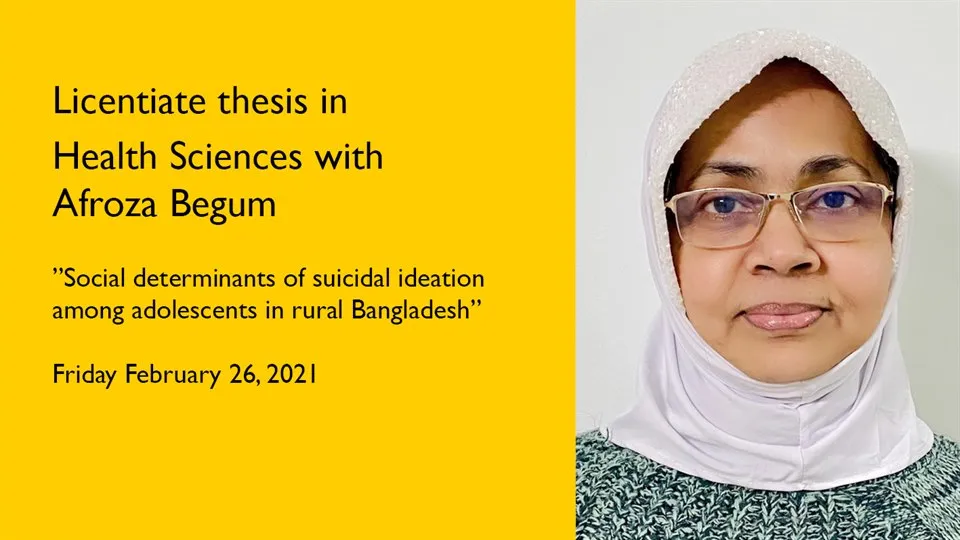Licentiate thesis in Health Sciences with Afroza Begum
Welcome to the Licetiate thesis in Health Sciences with Afroza Begum who vill defend her thesis: Social determinants of suicidal ideation among adolecsents in rural Bangladesh. NOTE: You must register to participate at the seminar!
Department of Health Sciences
Supervisor: Professor Gloria Macassa
Opponent: Kastytis Šmigelskas, Professor of Psychology, Department of Health Psychology, Faculty of Public Health, Lithuanian University of Health Sciences
Short summary
Although the prevalence and determinants of suicidal ideation among adolescents has predominantly been studied in high income countries, it is a growing public health threat worldwide. Adolescent suicide and suicide ideation are underreported in Bangladesh, just as they are in other developing countries.
Thus, the present study aimed to identify the prevalence and socioeconomic determinants of suicidal ideation in a rural area of Bangladesh. The current study showed that the prevalence of lifetime suicidal ideation among adolescents is quite high in a rural community of Bangladesh. Moreover, social determinants of suicidal ideation, such as parental marital status, education and home ownership as well as the adolescent’s education, occupation, living with parents or others, were associated with suicidal ideation after controlling for potential confounders.
Abstract
Background and Objective
Suicide is a leading cause of death and a critical public health problem among adolescents worldwide. However, adolescent suicidal behaviour is a neglected public health issue, especially in low- and middle-income countries, such as Bangladesh. There is evidence from developed countries showing that suicidal ideation (SI) among adolescents is related to social indicators as well as individual risk factors. Scarce evidence from studies in low- and middle-income countries suggests that social factors may influence adolescent SI. In Bangladesh, only a few studies have focused on the social determinants of suicide, and the present study is the first to examine the prevalence and social determinants of suicidal ideation among adolescents in rural Bangladesh. Therefore, the present thesis assessed the effects of socioeconomic status (SES) on adolescent SI.
Methods
The present thesis is based on two studies, which used data from a cross-sectional survey conducted in 2013 among 2,476 adolescents aged 14-19 years selected randomly in a rural community in Bangladesh. An adapted version of the WHO/SUPRE-MISS questionnaire was used to collect data in the Raiganj sub-district, an area surveyed within the Injury Prevention Program of the Centre for Injury Prevention and Research, Bangladesh (CIPRB). Study I estimated the prevalence of suicidal ideation among adolescents and investigated what factors were associated with suicidal ideation. Study II examined the relationship between parental socio-economic factors and suicidal thoughts among adolescents.
Results
Study I showed that lifetime prevalence of suicidal ideation was 5% among adolescents. The majority of adolescents with suicidal ideation were female (67, 5.3%), unmarried (106, 5.5%) and students (86, 6.2%). Suicidal ideation was significantly associated with age, education, occupation and living with parents or others. Respondents aged 18-19 years, had a Secondary school certificate (SSC) and Higher Secondary school certificate (HSC) or higher, were day labourers, living without parent had odds ratios of 2.31 (CI 1.46-3.65), 2.38 (CI 1.51-3.77), 4.15 (CI 2.41-7.14), .28 (CI 0.13-0.60) and 1.80 (CI 1.07-3.03), respectively.
In study 2, results demonstrated that suicidal ideation was more common among adolescents with parents from the low-income group (5.5%). In addition, adolescent SI was found to be significantly associated with parental education, marital status and house ownership. Adolescents whose parents received an SSC or higher had an SI odds ratio of 2.10 (CI 1.21-3.64) and 1.92 (CI 1.15-3.23) for mothers and fathers respectively. Suicidal ideation among adolescents with single parents was higher with an odds ratio of 3.00 (CI 1.75-5.19) in comparison to adolescents who had both parents. Adolescents whose parents owned a house had an odds ratio of 0.14 (0.05, 0.35).
Conclusion
The thesis found that the prevalence of lifetime suicidal ideation among adolescents is moderately high in a rural community of Bangladesh. Furthermore, it was observed that personal characteristics, parental marital status, education and home ownership were statistically significantly associated with suicidal ideation among adolescents even after adjusting for potential confounders.
Keywords: Prevalence, factors, Socio-economic, Parents, Suicidal ideation, rural, adolescents’
